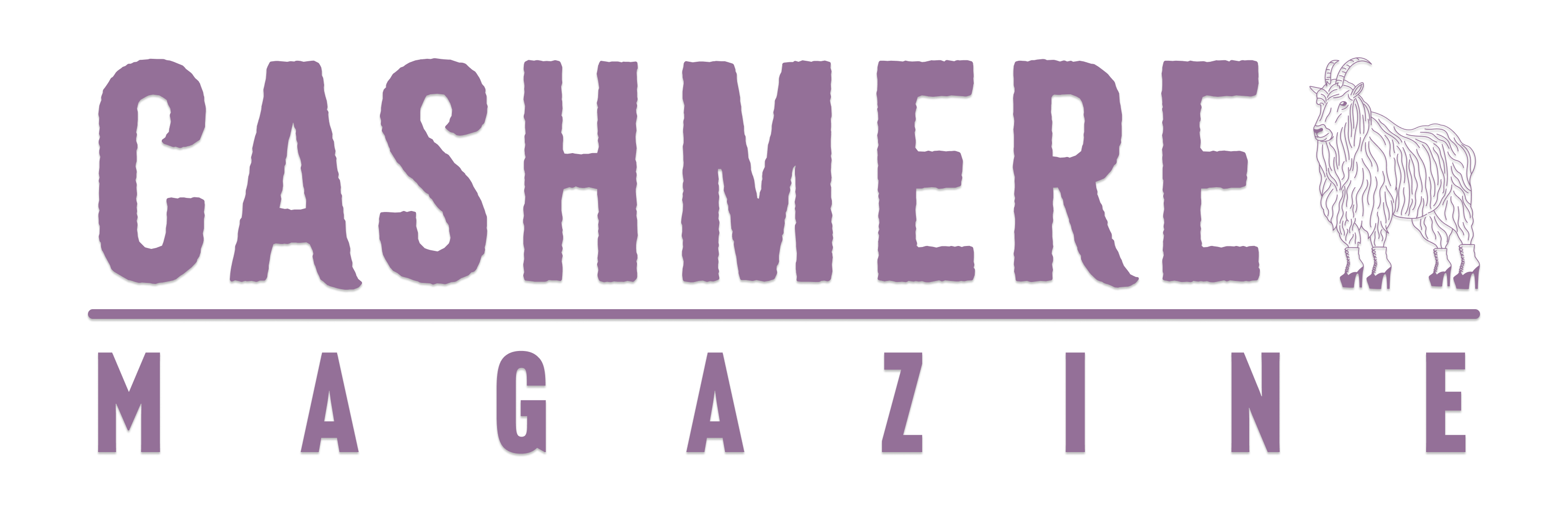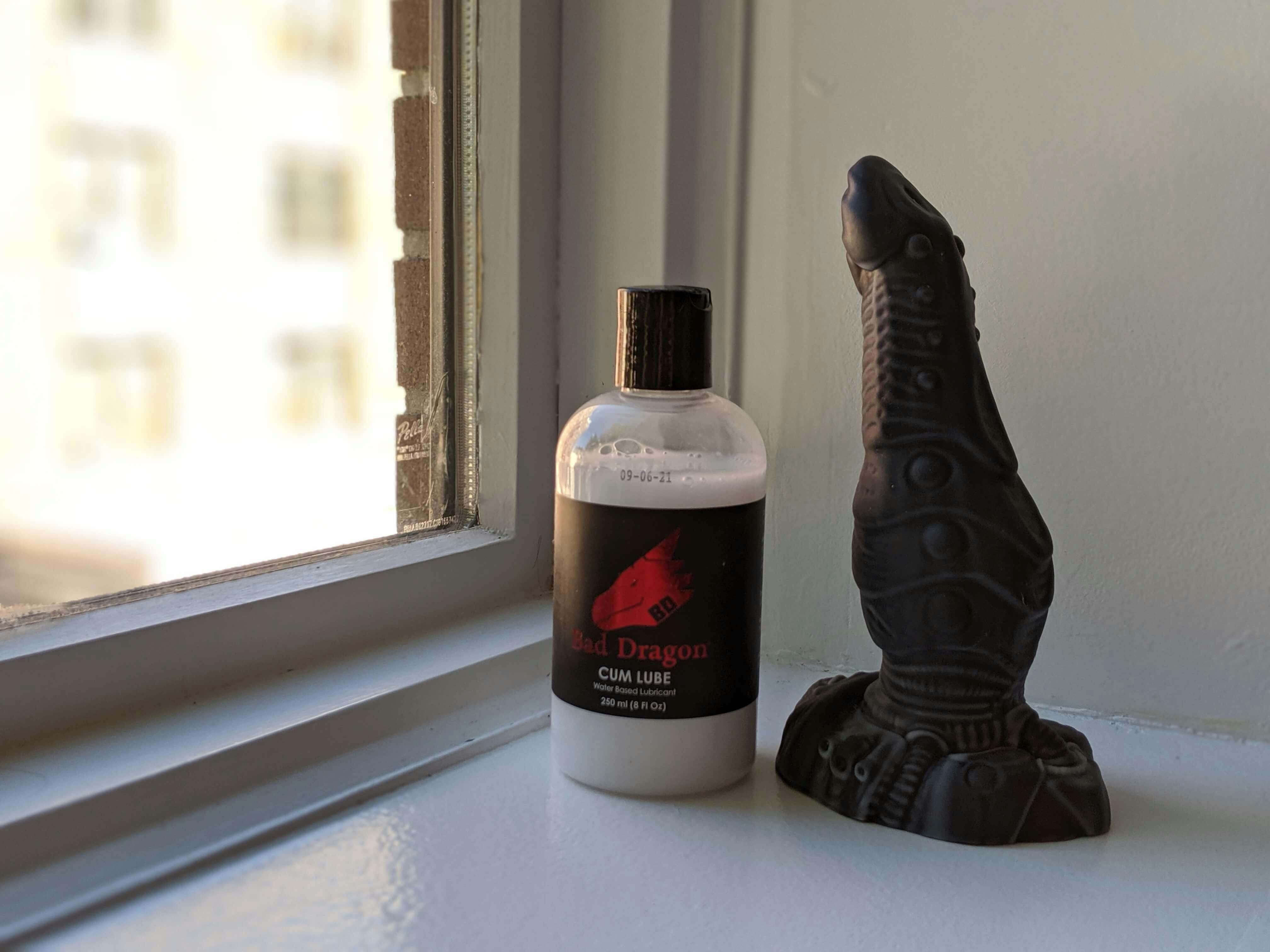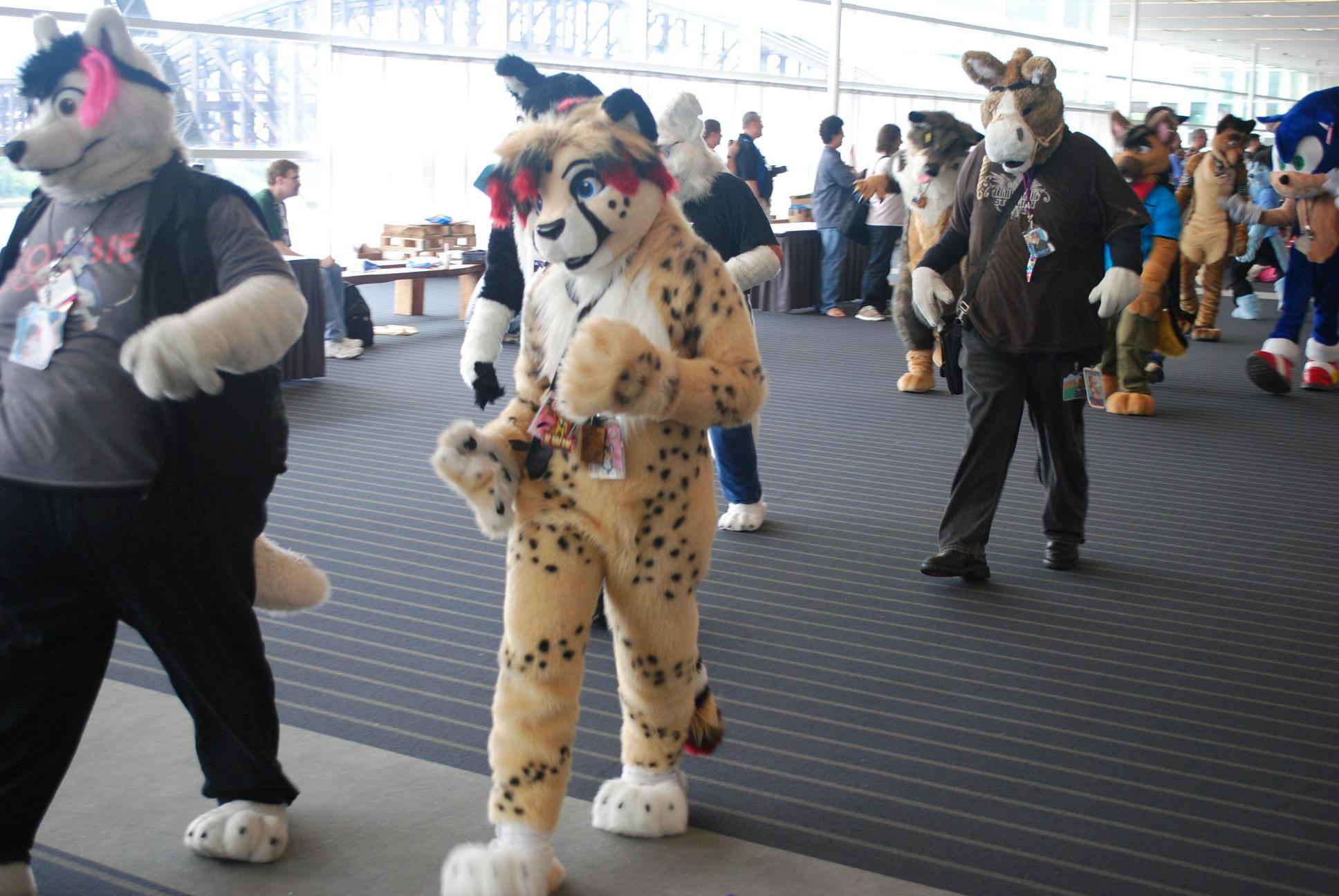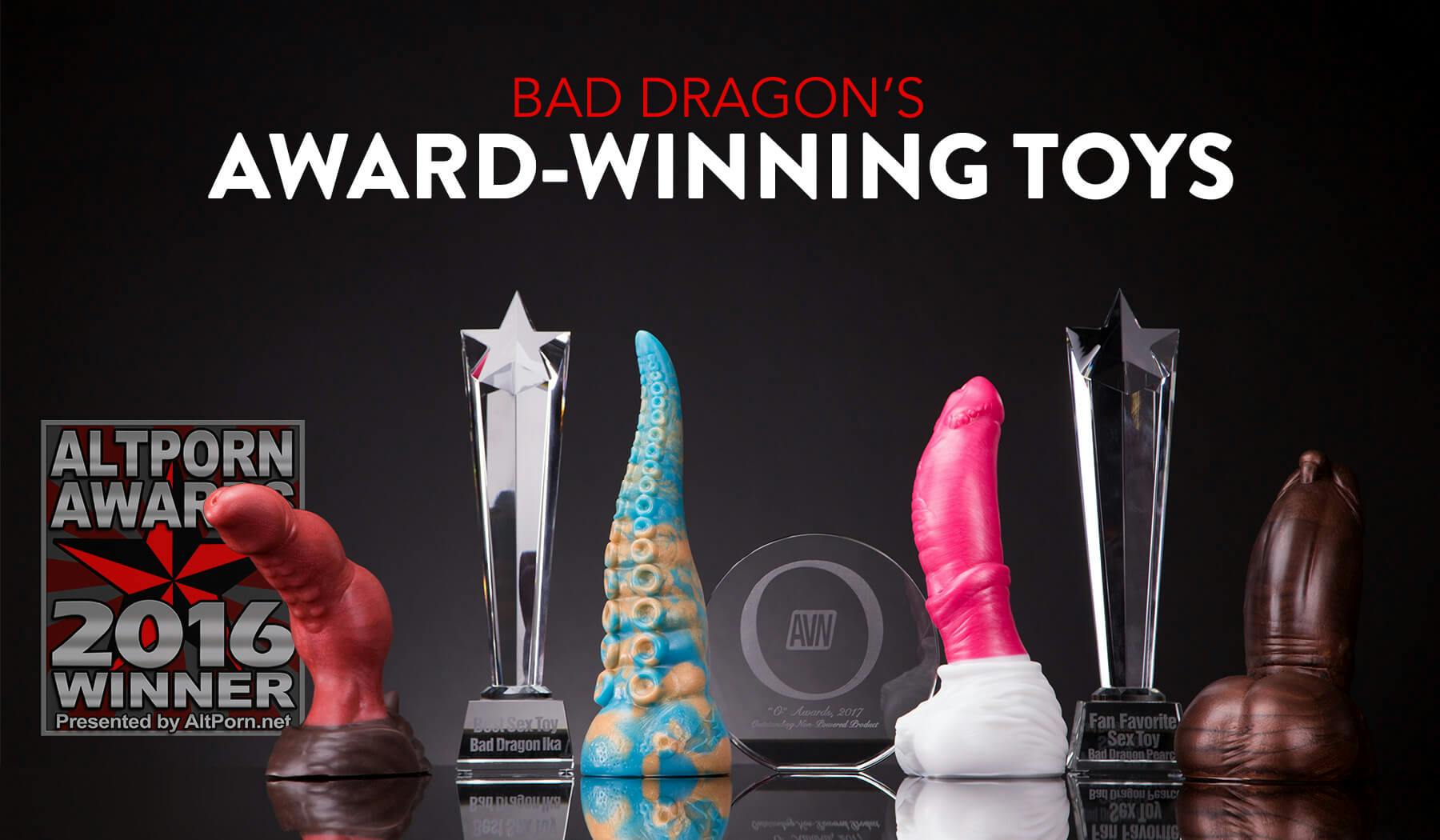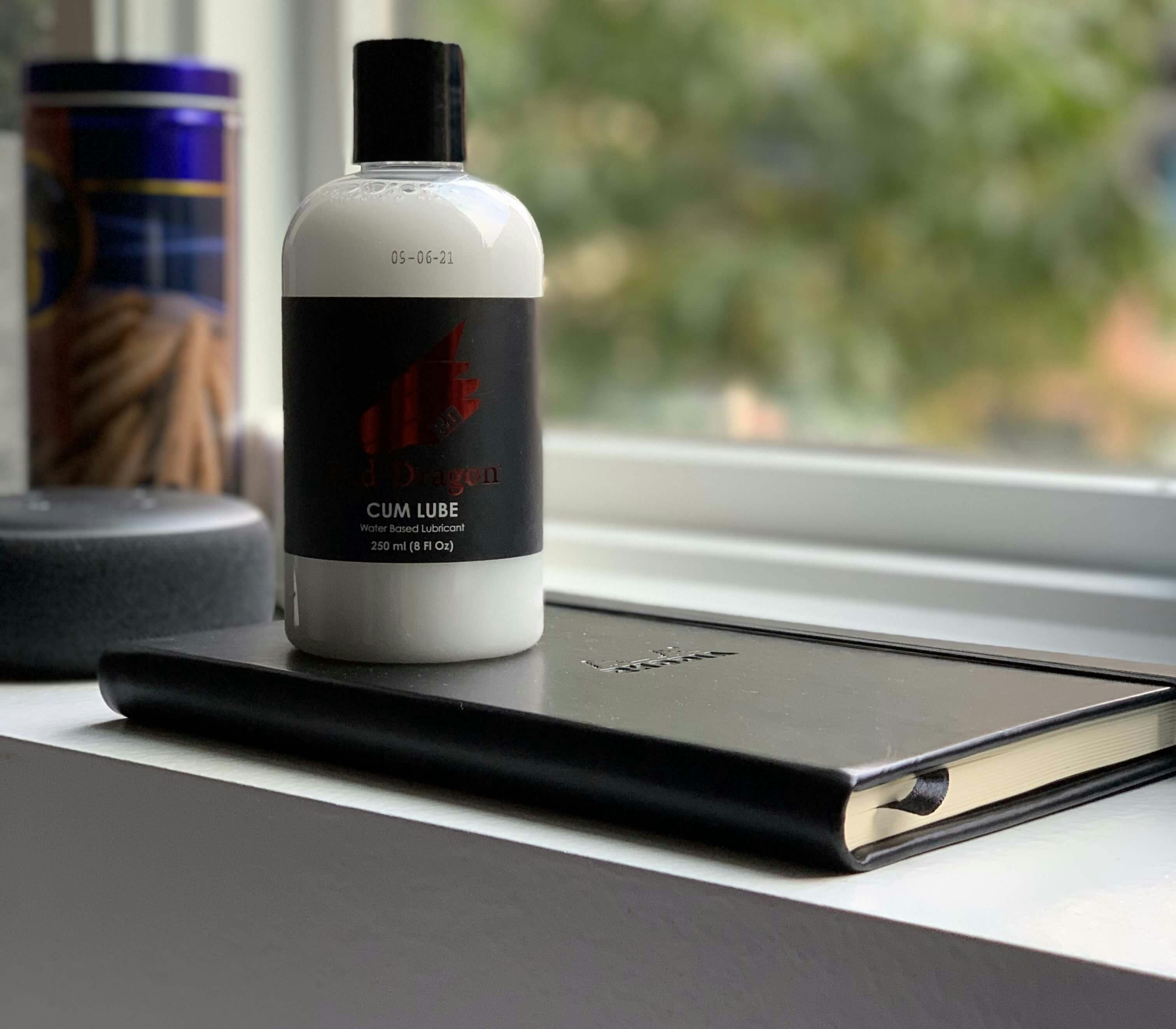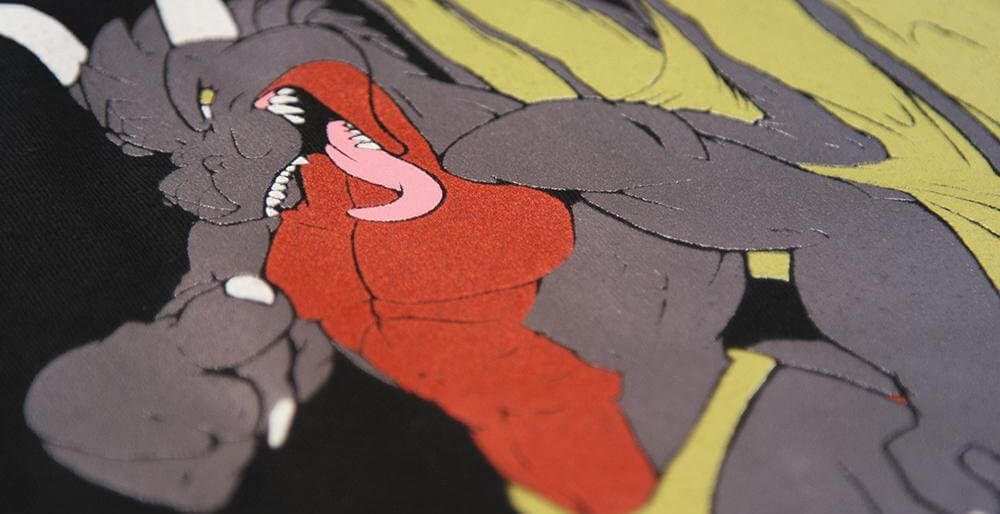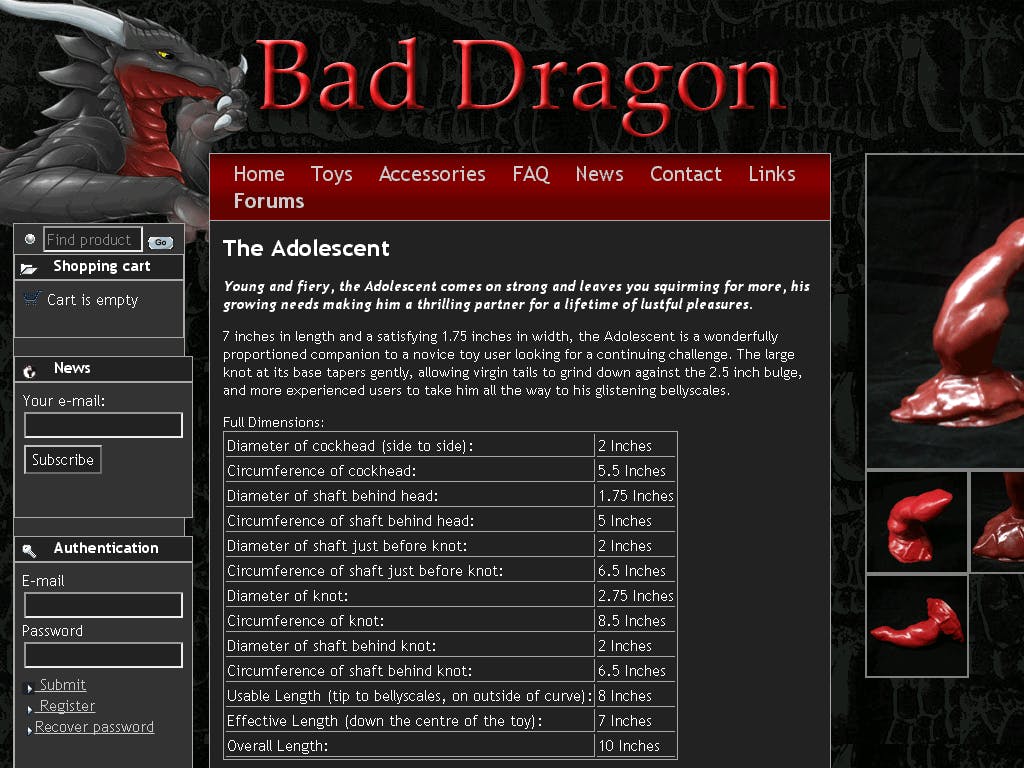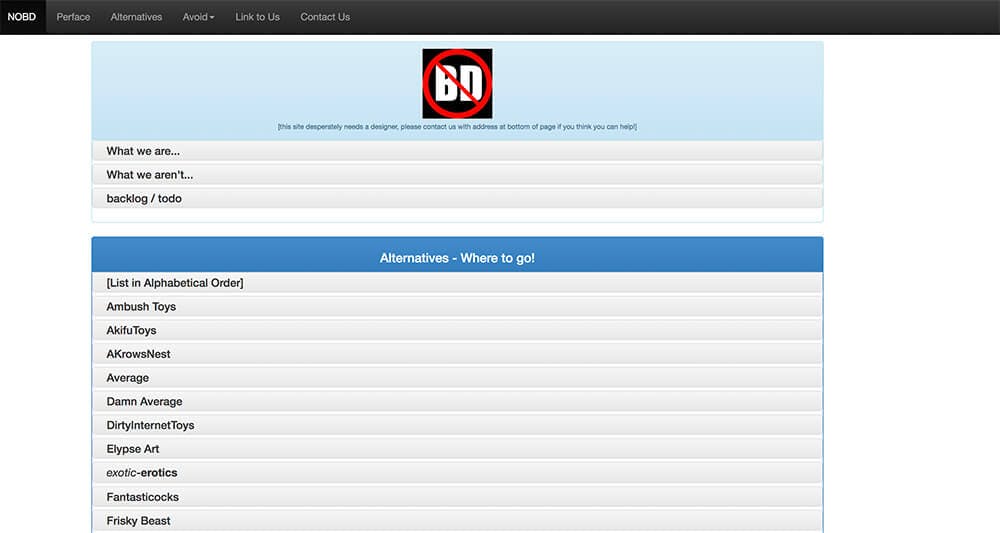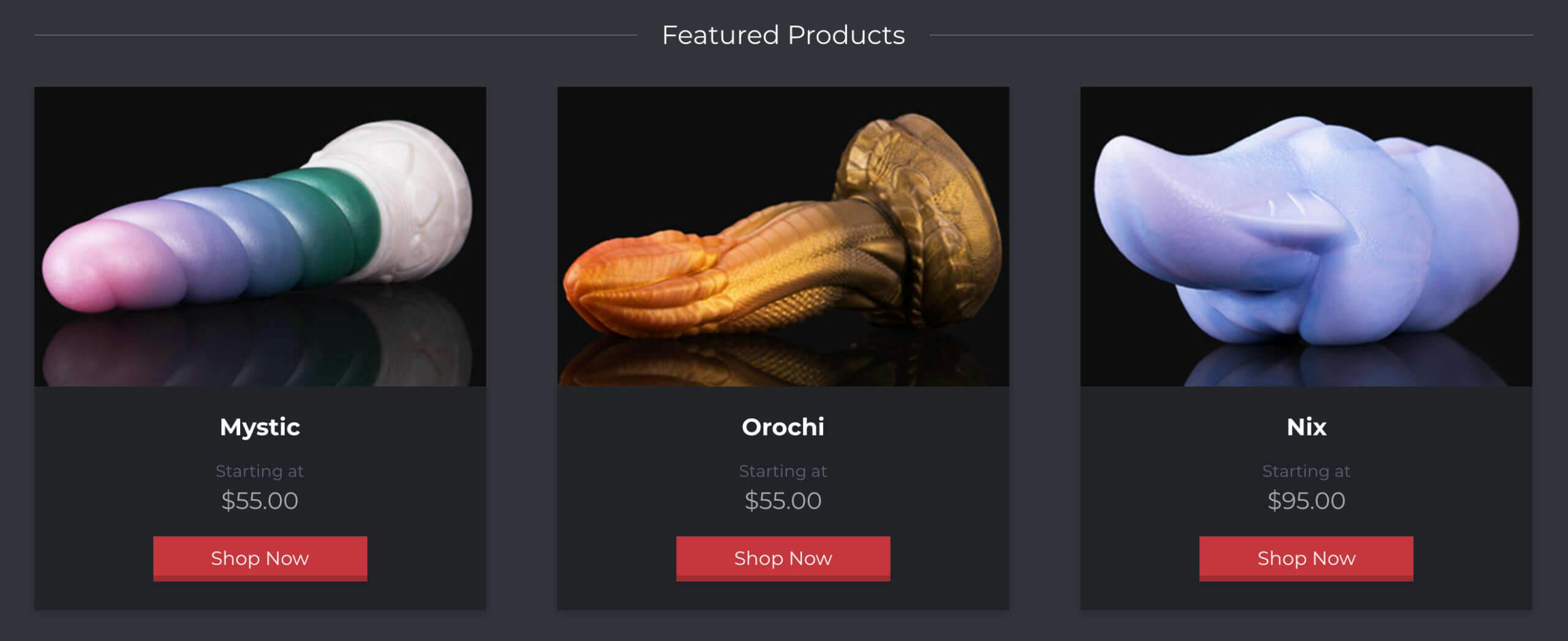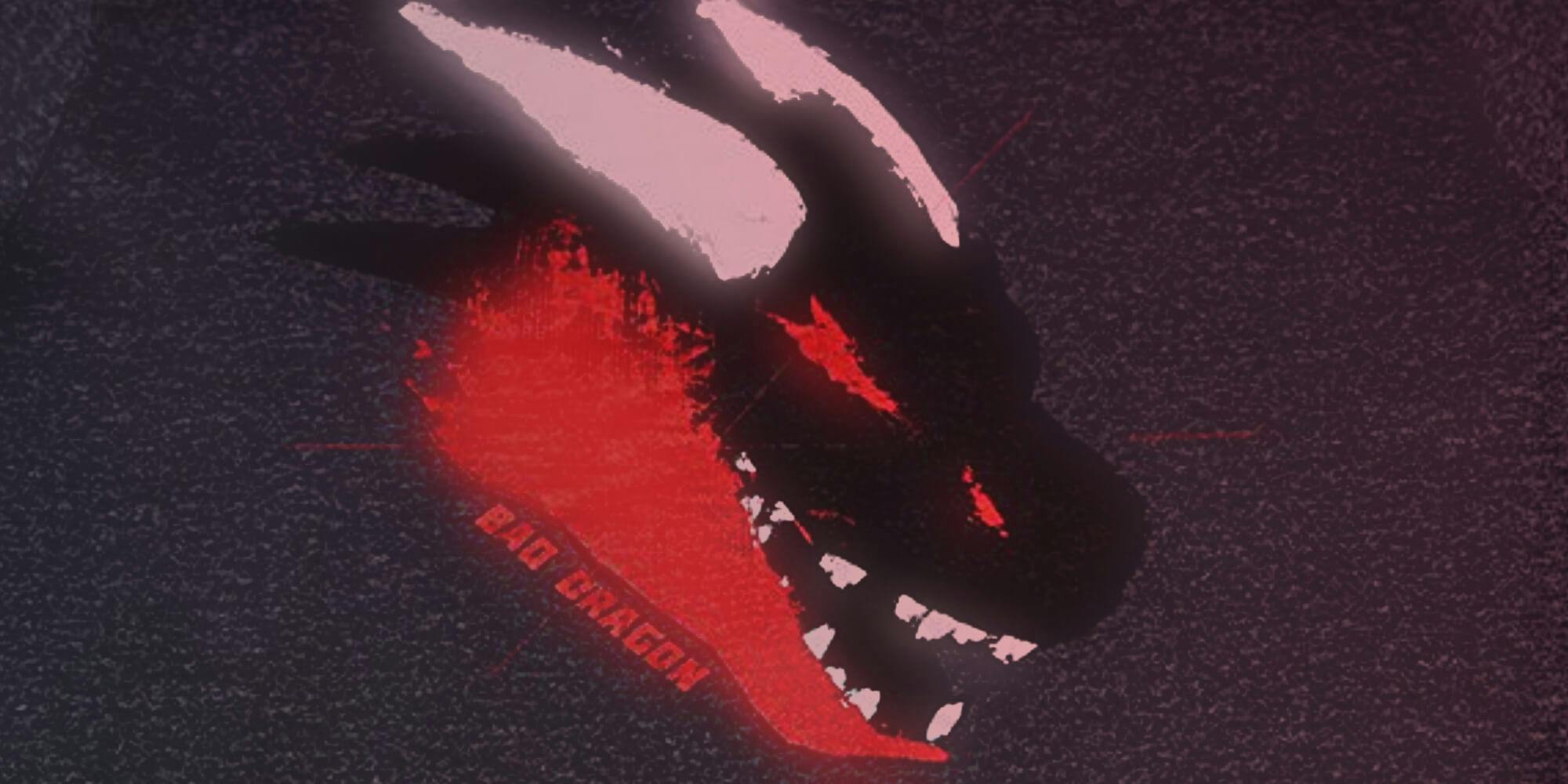Warning: The following article contains sexual content.
The Ridley dildo’s online photos are misleading. It looks even better in person.
Its silicone build is thick yet soft. Ridges, circles, and nooks are masterfully split into its shaft, culminating in a gorgeous tip that’s only somewhat human. The head gives way to a thin frenulum, followed by a bulbous trunk and flared base. Tucked inside a leather harness, it’s a sight to behold.
The Ridley looks like it should belong to Samus Aran’s nemesis, the dragon-like Space Pirate leader with the same name from Metroid. But according to fantasy sex toy manufacturer Bad Dragon, the Ridley belongs to the “genetic offspring of a dragon” and an “extraterrestrial from a far away planet.” The description gushes that Ridley is “quite the exotic lover,” one that promises “a more sensual thrill” from his member.
“So what do you say?” An image shows an enormous alien dragon flashing sharp fangs and dripping with cum from his erect cock. “Will you indulge yourself in this otherworldly fantasy?”
Purchasing a Ridley is certainly indulgent—the toy will set you back $75, and that’s before customization and shipping—but the quality is remarkable. Unlike your standard furry tail butt plugs at Spencer’s, the Ridley is as well designed as it is intricate. The toy is made-to-order and hand-poured with high-end body-safe silicone. Paired with Bad Dragon’s cum lube, it’s an otherworldly experience—and a challenge for even a seasoned bottom. That’s part of Bad Dragon’s appeal, after all. There are dildos, and then there are Bad Dragon dildos.
In the fantasy sex toy world, Bad Dragon is synonymous with anthropomorphic sex. Know Your Meme erroneously credits the company with inventing dragon-themed dildos in 2008 (the first dragon dildo dates back to at least 2002). But it’s an understandable mistake: Bad Dragon is the de facto face of the fantasy sex toy market. Its leadership is also unmistakably queer, as are its intentions. From the very start, its products were purposefully designed with queer men in mind.
But a queer company is still a company. And while Bad Dragon’s toys can be seen everywhere from Pornhub to Twitter, its history is as complicated and messy as its toys are luxurious.
Before dragons, furries
Sex historian Hallie Lieberman notes the very first sex toys came from the Upper Paleolithic period 30,000 years ago in parts of modern-day Germany and Eurasia. Our ancestors made “phallic batons” from animal parts like bone, ivory, and teeth. These days, animal byproducts don’t necessarily factor into the equation; many boutique sex toys use body-safe silicone, a polymer manufactured with synthetic compounds. But sex toys’ animal legacy lives on in one of the internet’s most controversial communities: furries.
In its most basic definition, a furry is someone who “generally [expresses] an interest in anthropomorphic animals and/or creatures (and perhaps [has] some affiliation to furry fandom),” according to WikiFur. The furry community is an enormous umbrella that includes a wide assortment of people, from those who dress up in furry suits (fursuiters) to fandom artists.
The furry fandom predates the internet, as do its queer roots. Gay couple Mark Merlino and Rod O’Riley hosted “funny-animal-themed” room parties at sci-fi conventions in the ’80s, which culminated in the world’s original furry convention, 1989’s ConFurence. Queerness and kink walked hand-in-hand early on; in his book Furry Nation, author Joe Strike writes ConFurence had “a more adult vibe” than today’s furry conventions, including a cabaret show called Fur Le Dance and a “slave auction” (later renamed a “pet auction”).
As the con grew in popularity over the years, so did moral panic about its queerness. One story claimed a furry left a hotel elevator covered in “jizz,” Strike notes. Another said a convention goer walked around with “nothing more than a Dixie cup covering his genitals.” Merlino’s sexuality was quickly targeted.
“[ConFurence] very, very deliberately billed the convention as a sex party. They advertised it heavily in the fetish community,” Anthrocon CEO Sam Conway says in Furry Nation. “By ConFurence 6 it looked like PrideFest.”
Merlino himself says “nothing happened at ConFurence that hasn’t happened at other conventions.” But the damage was done. In 2001, George Guley’s Vanity Fair feature “Pleasures of the Fur” would cement the furry fandom as a community of animal-obsessed sex-havers, equally terrifying and fascinating.
Today, most furries want you to know it’s not necessarily a sex thing, but it certainly is a queer one. Vice’s Kerry Neville, the mother of a furry, calls the fandom a “happy home for large numbers of non-heterosexual, transgender, genderqueer, and gender non-conforming people,” one that embraces “many who feel stigmatized at home, school, and work.” Statistics suggest the furry world isn’t just queer-friendly: Less than a third of furries identify as straight.
“Data suggests that only 30 percent of furries identify as exclusively or predominantly heterosexual, numbers that clearly differ from the general population, where nearly 90 percent identify as exclusively or predominantly heterosexual,” Courtney Plante, a researcher on the furry fandom, told Vice. “When a person isn’t forced to conceal their identity or live in fear of ostracism, they can begin to grow and flourish as a person.”
In a community that’s subversive, playful, and antagonistic toward the heteronormative belief that one should “grow out” of anthro characters as an adult, furry porn gives room for experimentation that’s inclusive and kinky.
Furry porn is also conducive to experimentation with sexual technology. Guides for building a fursuit from scratch were common during the ’90s, and many fursuiters historically engaged in sexual intercourse while in garb. Some even modified their suits specifically for intercourse. One popular late ’90s survey (or “furvey”) on Usenet forum alt.lifestyle.furry reveals fursuit sex was considered commonplace within the community before the 21st century.
“I like [fursuit sex] because I feel that much closer to who I am as a furson, and as such I seem to enjoy it all that much more, but I can have just as much fun without it,” one user wrote in 1998. “It’s like an added bonus to an already wonderful experience :)”
Fursuit sex intersected with another DIY sexual community in the furry fandom: plushophilia, a sexual fetish for plushie objects like stuffed animals or furry costumes. Like yesteryear’s improvised “phallic batons,” some plushophiles take stuffed animals and modify them, either with a strategically placed appendage (SPA) or a strategically placed hole (SPH). This wasn’t done to sexualize the plushie but to further enhance its erotic capabilities. One 2005 guide by renowned plushophile Mryia “Atomhirsch” Jacaklope teaches kinksters how to add an SPH to a kangaroo, complete with developing a pink satin sleeve.
“A stuffed SPH like the one I make is nice to feel and wonderfully tight,” Jackalope writes, showing off his construction process. “You can’t resist to push your fingers into. :-)”
It only makes sense that furries would keep pushing the boundaries for sex tech. By the turn of the 21st century, furries turned inward, looking to not just refine their DIY sex tech skills but to monetize them.
The alpha (and Zeta) toys
Zeta Creations, now known as Zeta Paws, opened its online doors in 2001. Run by furries Brownbear and Talarath, Zeta’s entire toy creation process is done by hand via Brownbear’s handiwork. Zeta is no Amazon: Like many small businesses with custom order products, getting your fantasy sex toy can be a bit of a wait. In a 2010 FAQ, Zeta says customers should “allow at least 4-6 weeks” for their orders to be made—and not much has changed. One Reddit thread from late 2014 shows customers claiming they waited from eight months to a full year for their toys, and a poster in 2016 acknowledged similar issues.
In 2001, boutique, high-end, luxury sex toys didn’t have brick-and-mortar locations. Feminist shop Babeland opened its first New York location in 1998; its second didn’t arrive until 2003. Iconic sex shop Good Vibrations didn’t expand outside of San Francisco until 2006. Portland’s She Bop, a household name to Bitch magazine subscribers, arrived in 2009. Straight cisgender women could barely find brands creating high-end niche goods, let alone furries. And while Zeta didn’t invent furry sex toys, it was the first company to successfully introduce the fantasy sex toy industry’s business model: an online, independent store run by and for a niche community, particularly with queer buyers in mind. (Zeta Paws did not respond to the Daily Dot’s request for comment.)
Other companies soon followed. FurryStyle emerged in 2005. Germany’s YiffyToys.de popped up in 2006. Then came FetishZone in 2007. While technically competitors, furry sex toy creators didn’t see themselves as rivals. They focused on community-rearing and sharing techniques. Many bought toys from each other and encouraged their customers to shop from their colleagues. The more competition, the argument went, the better for everyone.
Furries traditionally perceived the world through an us-versus-them mindset, and for good reason. A hatedom specifically targeting furries and depicting them as deranged predators emerged after Vanity Fair’s 2001 piece. One early 2000s site, “God Hates Furries,” argues furrydom hosts “very insane, very horrible, and very obnoxious Furries” that “abandoned all that is good and decent in order to live a life of depravity and sin.” The site condemns plushie sex and argues queer furries engage in fursuit sex solely because “women won’t touch them.”
“While it’s true that not ALL Furries take delight in reading stories about gay threesomes featuring Disney characters, the majority do,” the site claims. “Is it really unreasonable when presented with all of this evidence to come to the conclusion that the vast majority of Furries are into some incomprehensibly fucking weird stuff? No, no it’s not.”
The condemnation brought furries closer together and encouraged retailers and customers to see one another as participating in a unified subculture, not a customer-service relationship. When the Norwegian Federation for Animal Protection petitioned Norwegian adult novelty store Kondomeriet to ban “sex toys in the shape of animals” in 2004, furries on Zeta’s LiveJournal community came together and defended the furry retailer’s toys.
“I don’t see why anyone should care what toys we play with. Do people want us fucking ourselves with the Zeta toys we all know and love, or would people rather we go out and find the real thing?” one user wrote.
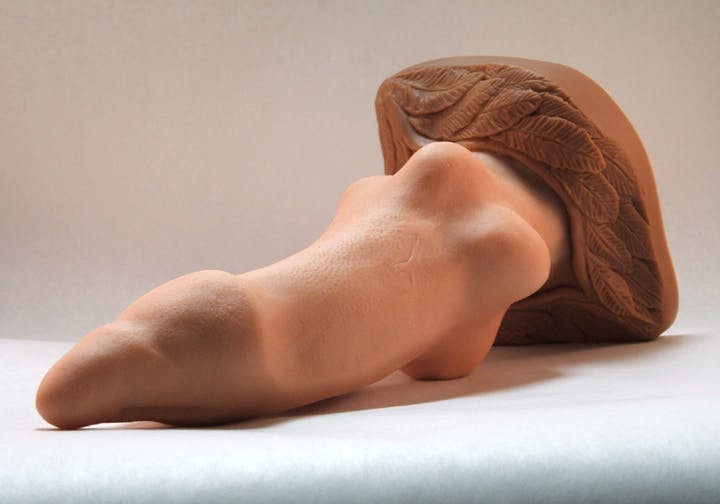
It’s undeniable that furry hate and homophobia walk hand in hand. The furry community’s alternative sexuality, in all of its playfulness, encourages redoing, reimagining, and recasting sex. And while not every furry is queer, some of the biggest names and companies in the furry community certainly are. That was especially true for Bad Dragon. Early on, Bad Dragon’s CEO and co-founder Jan “Varka” Mulders embraced an alternative view of gender and sexuality that merged furrydom with nonbinary identification.
“[G]enders are complicated, especially for a group of sexual ‘weirdos’ like us,” Varka wrote in 2009. “For example, if we take ‘fursonas’ or spiritual identities into it, I’m a hermaphroditic, androgynous (as in, you can’t tell what gender I am from general appearance) dragon, that goes through male and female phases on a cycle, who likes males, females and other hermaphrodites (but only at the right time!). Of course, if you take the practical view of ‘orientation,’ I’m a mostly-gay, surprisingly abstinent human guy with desires and personality that cross over between male and female mental viewpoints.”
And it’s these ideas that drive various genders and sexualities to Bad Dragon’s products.
Enter Bad Dragon
If you’re a furry, you’ve probably used something owned or moderated by Varka. That includes imageboard e621 and kink and roleplay site F-List, respectively. But Varka is best known for his role as CEO of Bad Dragon.
Created in 2008, Bad Dragon sells realistic, boutique fantasy sex toys and accessories. Many of its toys mirror real animals, like horses and dogs, but most are purely fantastical: dragons, tentacle creatures, sea monsters, even demons. Today, Bad Dragon is a household name among sex toy fans and adult industry members, both as a high-quality retailer and, as Urban Dictionary puts it, attracting “people who wish they could have sex with dragons.”
Bad Dragon’s history began in late 2007 when Varka posted a thread called “Animal ‘Toys’ ;-)” on his adult furry art forum Herpy: Reptile Lovers’ Community. Varka adored Zeta’s Gryphon dildo, but the furry sex toy retailer was stagnating and its build quality suffered from their vinyl materials, he said. It was time for a change. So Varka brainstormed his own lineup prioritizing silicone toys. These would focus on several fantasy creatures, such as dragons and gryphons, along with real animals he considered doing “live-casts” from—that is, toys built from molds of real animals’ genitals.
“Let’s face it, for a lot of us this is the closest we’re (legally) going to get to the real thing—I’m in it for the experience and the love—and I’m planning to do live casts (ie, a gator cock cast from a live gator) too,” Varka wrote. Potential live-casts included vaginas and penises from horses, ponies, cows, sheep, dogs, and “most anything else human usable that people might be interested in.”
The idea excited Herpy users at the time. While furry sex toys were already available online, no one in the furry community tried to create a high-end, detail-oriented fantasy sex toy line that promised an immersive experience bordering on realism. Zeta was nice, sure, but this was about turning sexual fantasies into near-realities.
(Editor’s note: This quote has been edited for clarity.) “[The] only thing that sadens me is im old and only wish you were doing this 34 years ago when i was a teen scalie,” one user wrote on Varka’s original thread. “To all you [young] scalies now is the time to live you are going to get the best [sex] toys and in a few years real loving scalie robots [too].”
Varka never went through on using real animals for Bad Dragon products, in part because live-casting “takes things a little too far into ‘zoophile’ than I’m comfy with,” as he wrote in 2008. But he did tap into a niche that no high-end adult store cared to touch. And he struck big. Bad Dragon launched in June 2008, and one month later at Anthrocon 2008, its toys were the talk of the convention.
“Basically, on Day 1.. things were a little slow. We made a little over half a dozen sales, but handed out lots of business cards, which were scattered on the table,” Bad Dragon Forum user PhrostDragon wrote that July. “The next two days, we were growing large crowds every ten minutes. As soon as a couple people would stop and look, that alone, would draw even more, thanks to the ‘What’s this all about?’ factor. In the end, we sold around two dozen toys. That’s really hard to do, considering.. we’re selling DILDOS. From a public stall, in the middle of thousands of other people.”
Bad Dragon’s forum users were predominantly men interested in dildos, although women also joined the community and praised the company’s products. Or to quote Varka, “you’ll find that females tend to lurk a lot, especially with horndog males around.” Over 10 years later, Bad Dragon’s lineup is much more diverse and popular with a wide assortment of genders; the company offers masturbators, cock sheaths, packers, and cum applicators. The brand even has a water-based “cum lube,” which looks and feels like the real thing (it’s even immensely sticky). Bad Dragon is the king of the fantasy sex toy world by far, and the industry reflects the company’s vision in all the good and bad.
A fantasy soaring
Since 2008, body-safe silicone has become an industry standard. Dozens upon dozens of small fantasy toy retailers have cropped up offering their own products to a specific niche. Technically, they compete against Bad Dragon on the market, but they don’t see Varka’s enterprise as their competition. As two small retailers told the Daily Dot, there’s enough room for everyone.
“Honestly, the term ‘competitor’ has become less and less relevant in the last few years. The processes and materials for making these toys have become way more available and democratized, and anyone with enough creative drive can pick up some tools and bash out their own stuff in a matter of weeks,” Kara, the owner and creative director for U.K.-based furry sex toy company Weredog, told the Daily Dot. “There’s a really cool, collaborative feel developing in the market, where newer companies don’t feel the need to obscure all their special trade secrets.”
Communal sharing can even give birth to new companies. Toy Poodle Customs’ creator, who calls herself the Top Poodle at the company, started making fantasy dildos last year after reading a forum thread where a poster shared their tools of the trade.
“The material cost is fairly high, so big companies are definitely at the advantage there, but if you can get a good run of some niche design out to the community that’s interested in it, you can make enough money to keep going,” the Top Poodle told the Daily Dot. “But I never felt in competition to the other makers. There’s enough horny for everyone, and the designs are all so unique it doesn’t feel like we’re competing for the same buck.”
Fantasy sex toys’ appeal goes beyond fucking an anthropomorphic creature. The toys’ challenging shape and size appeals to many non-furries, especially those that “like them bigger and bigger,” as the Top Poodle said. Customers tend to agree, and it can even expand their sexual preferences. One trans woman, Ronnie, developed a kink for alien fetishism “after a couple minutes” using a Bad Dragon toy.
“I saw [Bad Dragon dildos] being used on Chaturbate a lot a couple years back. And I was intrigued by the curvy shapes and the fact you can stand it on the floor or a table or whatever and go nuts and it won’t fall or anything,” Ronnie told the Daily Dot. “So I bought one. And it’s like, really great for exactly what I thought it’d be great for, which is prostate stimulation.”
Ronnie considers her dildo “the highest-end toy” she owns aside from her Hitachi Magic Wand. She isn’t alone. Bad Dragon’s toys are incredibly popular with adult performers, both because of their high-quality builds and fans’ interest in Bad Dragon. Trans adult performer Aubrey Leigh first saw Bad Dragon’s toys in DIY porn videos and on ManyVids. Intrigued by their unique designs, she bought a dildo as “strictly a work purchase” hoping it would help raise tips during cam shows.
“My first purchase was a Bad Dragon Tyson, in their second biggest size. Since most Bad Dragon products are made to order, it took about six weeks to arrive, and when I got it, I was impressed with the quality,” Leigh told the Daily Dot. “I was expecting it to be well-made due to the high price relative to mass-produced toys, and the actual product met or exceeded my expectations.”
On Chaturbate, Leigh prices her videos with her Bad Dragon Tyson at 301 tokens (approximately $30), a rate she’s “not sure if [she] could get” for a comparable toy. It’s hard for her to say for certain if Bad Dragon earned her fans or not, although she has noticed viewers regularly comment on the toy.
“I think part of the appeal among indie producers is that, due to the fierce competition and abundance of content on sites like ManyVids, there needs to be a way for their particular clip to stand out,” she explained. “If a very large, very colorful, and very uniquely shaped toy features prominently in their video preview, it really does catch the idea of buyers who might be rapidly scrolling through pages of new clips looking for the one that most excites them.”
Data from Pornhub confirms this to be the case. The Daily Dot found the top 25 Bad Dragon searches provided by Pornhub generally refer to names, categories, and adjectives for specific toys, as well as unboxing and review videos. This is perhaps a testament to brand loyalty for the product.
“[Bad Dragon] did a huge service to the whole industry by making alternative sexuality a more normalized, healthily-viewed thing, encouraging folks to use their imaginations more,” Kara told the Daily Dot. “I’m certain we would have seen less success if it weren’t for their efforts in the last 10 years.”
A capitalist fantasy in queer clothing
Varka saw his fellow sex toy retailers as colleagues and friends. But early on, furries stoked competition between Bad Dragon and other companies. One controversial thread from 2008, “Bad Dragon toys Vs Zeta,” quickly turned into a debate over Zeta’s quality compared to Bad Dragon’s. This was partially sparked by Bad Dragon’s customer service head Runa, who wrote that Bad Dragon’s toys “are considerably more textured,” whereas Zeta’s “can be good for the beginners, but not for anyone looking for a real good time.”
Runa’s antagonism became a recurring issue. When he implied newcomer Exotic-Erotics was “imitating” Bad Dragon, he got into a messy, multi-page fight with Talarath from Zeta Paws. Varka came in and made it clear that Bad Dragon saw its competitors as friends in a “friendly market,” but the damage was done. “We both know we dislike each other, and then coming on here and calling me ‘poster-child Talarath?’ Seems like an attack,” he told Runa in 2009.
Exotic-Erotics did not reply to a request for comment.
Runa, while fiery, was a popular community member. He was also notorious for lashing out at customers both on the forums and within support tickets. Bad Dragon was forced to make a choice: protect the company from liability, or meet the community’s wishes. Its executives chose the former. In August 2010, Varka announced Runa was being let go, claiming the “needs for the role of customer service were substantially different” from Runa’s capabilities. He would “still be welcome on the forums,” and Bad Dragon “fully” expected “to see him continue posting.” The post sparked four pages of debate. Some left the forums. Others defended Bad Dragon’s decision.
“Runa was removed from the company because of multiple instances where he could have been a liability to the company,” one user warned. “It’s not only because of his actions on the forums, but in other areas as well.”
In any other circumstance, Runa’s prior success would have set the foundation for a better, more professional candidate. But Varka’s announcement was somber and emphasized the new changes: Runa is gone, so don’t contact him and reach out to his replacement, SemJay, instead. Most of the post justified Runa’s dismissal, and Varka barely touched on SemJay’s qualifications. In fact, the company technically didn’t even let Runa go: While he was no longer a paid staff member, he was kept on as a volunteer forum moderator. From an outside perspective, this comes off as a weak compromise at best, exploitative at worst.
“I really think Runa getting fired should have been handled well away, behind the scenes and a small post to the effect of ‘Please welcome SemJay as the new public relations handler!’ should have been made,” one user, Rysta, wrote. “This, on the other hand, just gives me creepy feelings. I can see the discord going on behind the scenes. I know they’re having trouble. You never, ever want your customers to see that.”
Discord became an ongoing problem. Despite being much more level-headed than their predecessor, SemJay struggled to balance mod responsibilities with their customer service duties. Varka, meanwhile, let Runa openly criticize his replacement, both publicly on Bad Dragon’s forums and directly to him one-on-one (the latter of which Runa divulged on the forums).
A pattern was emerging: Bad Dragon could make very good toys, but it lacked ethical management. A 2011 post by Varka blamed shipments with “questionable trimming jobs” on a departing, experienced staff member “taking skills essential to the role” with him, leaving new staff unqualified. Shipping and production woes became an ongoing issue as customers complained their orders were coming in slowly or held for processing. As early as 2011, Varka acknowledged the issue and explained that as soon as wait times decrease, the company gets “a huge flood of orders from people excited that they don’t have to wait so long for their toy.” Yet nearly a decade later, Bad Dragon still struggles with sending out orders in a timely manner. After examining 83 Trustpilot reviews posted on Bad Dragon during 2019, the Daily Dot found the company’s reviews with either very high or very low satisfaction rates correlated with high volume orders. November is one of two months when the company sees the highest dissatisfaction rate.
Wait times remain a consistent issue in part because of how the company invests money: in growth. When one user wrote in 2011 that they were interested in a Bad Dragon toy but they were living off food stamps and only had a $50 monthly spending budget, Varka asserted that Bad Dragon is “about making fantasy toys, and charging what’s necessary to do that.” That means reinvesting money to “make things even bigger and better,” not sliding-scale options for the furry community where, according to a FurScience study, over half of the participants are middle- or working-class. At best, Varka lacked sensitivity. At worst, he simply assumed Bad Dragon didn’t owe anything to its low-income customers.
“Just for future reference,” he joked, “no, we have no intention of starting to accept food stamps as a payment option for Bad Dragon toys.”
Bad Dragon’s relationship with forum users became tense. This culminated in a 2012 public relations nightmare for Bad Dragon—or an explosive “shitstorm,” as one user wrote on furry-critical forum Vivisector. After a forum user openly complained that her order was sent with incorrect details, she was banned from both posting on the site and making any additional orders with Bad Dragon. Kamo, then serving as general manager, was responsible for the decision. Instead of standing down or resolving the conflict, he repeatedly and openly attacked the customer, calling her “extremely rude, abusive, and unwarranted.” Upper management ultimately took Kamo’s side.
“[W]ith recent events, and reoccurring issues that have kept showing themselves to us on the forums, we feel that a slightly more firm hand is needed, to help maintain, and keep them a more peaceful haven. This does not mean that you have to pretend [to] be happy all the time, but, we would at least expect you to show respect to your fellow forum goers, as well as the Bad Dragon staff,” Bad Dragon cofounder Raith wrote. “We understand that tempers can flare, and things can be said that aren’t entirely meant. But when we see repeat offenses, then it is time to take action, which we have, and will be doing as we continue.”
Varka later posted a thread shedding further light on the issue, acknowledging that the company mishandled the situation. However, he ultimately refused to unban the forum user and declared Kamo “the messenger who got shot as the actions he undertook were on behalf of Bad Dragon.” While appreciated by some, others could not forgive Bad Dragon for mistreating its customer. Varka’s post solidified the idea that Bad Dragon was a company, and it did not have furries’ best interests at heart. It was a business, and it ultimately wanted to make money. Kamo’s actions were merely the last straw.
Over the next few years, multiple Tumblr posts emerged detailing a laundry list of allegations against the company. Queer sex blogger Lilly Delvaux put Bad Dragon on her sex toy retailer blacklist under toy makers “with shitty ethics,” warning users to do their research. By 2017, a website named nobd.info emerged as a centralized source cataloging anonymous allegations against Bad Dragon, becoming the de facto website for providing alternate retailers.
“Everyone should understand that every company has its faults. A misplaced package, incorrect order, slow production queues, all of these are (generally) ignored [on this site] as a matter of relatively normal business,” nobd.info writes on its front page. “What is important, is when these issues are repeated frequently or poorly handled, or issues regarding unethical practices, suspicious behavior, or suspected/alleged illegal activities.”
Bad Dragon did not respond to the Daily Dot’s request for comment.
Underneath the scales
You probably aren’t familiar with “The Adolescent.” Clocking in at 7 inches high and 1.75 inches wide, this Bad Dragon dildo was available in 2008, early on in the company’s history. While The Adolescent has since been discontinued, the toy’s storefront page can still be seen via web archiving. As the name implies, The Adolescent simulates sex with a dragon who may be underage.
“Young and fiery, the Adolescent comes on strong and leaves you squirming for more, his growing needs making him a thrilling partner for a lifetime of lustful pleasures,” its description said.
While adolescents aren’t always under 18—Psychology Today notes the transitional stage “occurs between ages 13 and 19”—The Adolescent’s appeal lies heavily in its narrative. Users get to break in a young, eager dragon with “growing needs.” Not every Adolescent owner is aware of its history, or even thinks twice about it. But once it’s pointed out, it’s impossible to ignore.
“As far as it being an adolescent itself, I don’t know how I feel or felt about it, it’s a dragon you know?” one second-hand toy owner, LHughes, told the Daily Dot. “I guess as a fantasy I had at the time it was a young dragon, but it’s still an immortal dragon, haha, I assume not out of its egg. Looking back on it, it’s definitely a bit on the squicky side but eh, it’s a dragon, how old is an adolescent dragon? 40? 100? What even is underage with a dragon? But then even making arguments like that makes me feel icky.”
Bad Dragon “never sold anything explicitly” based on cub porn (that is, furry porn with child characters), LHughes said, and at the time the furry community was “way easier on cub stuff” in general. But 11 years later, it’s hard to look at The Adolescent and not feel uncomfortable. Sure, an “adolescent” dragon may, theoretically, be over 18 in mind, spirit, and body relative to a human. But then again—who thought marketing a sex toy around fucking a teenager was a good idea?
A similar problem can be seen with the Anthro Dragoness, now called the Janine. In her original backstory from March 2010, Janine had to have sex with her “mate,” Duke, to get a job at Bad Dragon. Then, Drake “convinced” her “that she would be doing the world a favor if she came in to make a toy based off her wonderful pussy.” An update to Janine’s lore from around 2013 involved her working for Duke and being asked to “shake that pretty ass of yours and get [a manila folder] down” for one of her colleagues, Cole. As it turns out, the folder contains a series of explicit photos “from one of her private shoots” with Duke, shared without her permission and used to create the Janine. The toy’s lore remained intact until May 2016.
Dubious consent (dubcon) and nonconsensual power fantasies (noncon) are erotic, fictional, and/or kinky scenarios where characters engage in sex where consent (or lack thereof) is either murky or overridden by another partner, respectively. While deeply controversial, dubcon and noncon aren’t inherently bad. However, unsolicitedly using these premises to sell a product may be more triggering than arousing in the post-#MeToo era. Nearly 10 years after Janine’s introduction, a U.S. Google search result analysis of “tentacle porn” and “tentacle rape” from 2014 to 2019 reveals the latter continues to experience a steady drop in search interest compared to the former. Tentacle porn searches as a whole are in decline as of 2019, but those sticking around for the genre seem much more interested in a diverse depiction of sexual desires than just nonconsensual adult content.
Questionable branding isn’t Bad Dragon’s only skeleton in its metaphorical closets. The website nobd.info has been dedicated to a collection of allegations against the company since mid-2016. The site started as a “collaborative effort of a few individuals gathering resources and building a very basic website,” an anonymous nobd.info coordinator told the Daily Dot. That source claimed nobd.info’s members were either unavailable for comment or “predominantly wish to remain anonymous,” but “all had significant involvement with Bad Dragon.”
On its front page, nobd.info caveats that “we’re bound to get some things wrong.” But the site’s supporters take it seriously and commonly share the site to inform potential customers. Among these allegations, one entry says Bad Dragon pushed its primary investor out of the company and left him in debt to the IRS, and several claim Bad Dragon stole designs from others.
“There was no one specific event, but instead a culmination of events that all started to build a much bigger picture,” a nobd.info administrator told the Daily Dot. “Originally, many of those negatively impacted by Bad Dragon did not realize just how many others also had similar stories. […] As they began to find each-other, one of them decided to centralize the stories and create a singular resource where all of them could be found in one place to show the bigger picture, and that was the foundation of what now is nobd.info.”
The most alarming allegation is by a furry who claims he filed a police report against Kamo Two Paws, Bad Dragon’s chief operating officer, after Kamo sexually assaulted him. The post also alleges Kamo “systematically” preyed on “many people both male and female, including minors,” and committed bestiality by “forcing dogs into sex acts.” When contacted by the Daily Dot, the Arizona Department of Public Safety stated no department records were found for “Kamo Two Paws” or his former legal name, “Eric Silveiro.”
An admin for nobd.info divulged to the Daily Dot a particularly troubling case in which an employee retained a lawyer and filed an Equal Employment Opportunity Commission (EEOC) complaint against Bad Dragon for disability discrimination. Additionally, the admin claimed that the company engaged in retaliation by spying on the employee and intimidating them via police “welfare checks,” in which Bad Dragon lied to police that the employee had a gun. The impacted employee, the admin alleges, ultimately “signed a severance agreement under duress” that involved both a non-disclosure agreement and a non-disparagement agreement. Information provided on background to the Daily Dot appears to corroborate that both an EEOC complaint was filed and the severance agreement was made. Additionally, a source close to the affected party said they could corroborate the nobd.info admin’s account, including the mental and physical toll of Bad Dragon’s treatment toward the employee. When reached for comment, the EEOC stated that it cannot confirm or deny the existence of an EEOC charge.
While nobd.info’s timeline against Bad Dragon ends around 2015, its coordinators aren’t necessarily convinced that Bad Dragon deserves the benefit of the doubt. It’s just as possible that “their practices have improved” as “they instead have gotten better at hiding the problems they cause,” the nobd.info admin said. Regardless, reaching accountability is still an ongoing goal for the website’s coordinators.
“Some of those involved with nobd.info have been approached over the years (since 2015) and been told ongoing events, but those involved have chosen to not publicly disclose their stories claiming threat of legal action,” the admin said. “Furthermore, with so many negatively impacted in manners that still have effect to this day, some refuse to consider Bad Dragon having improved without them directly addressing past transgressions and making amends.”
Despite the serious allegations against Bad Dragon, customers outside of the furry community seem unfamiliar with the company’s rocky history. The Daily Dot spoke to multiple Bad Dragon users across demographics, from sex workers to trans women who enjoyed Bad Dragon’s products, and in each case, sources commonly did not know about offensive marketing copy, unethical business practices, sexual misconduct allegations against Kamo, or any other claims levied toward the company.
“I had heard a rumor a while ago from another model that the founder of Bad Dragon made some insensitive remarks on a forum,” Leigh told the Daily Dot. “However, that’s the extent of what I’ve heard.”
An uncertain future
Bad Dragon markets itself as a down-to-earth, queer-friendly fantasy sex toy retailer with tongue-in-cheek marketing and high-quality products. But Bad Dragon isn’t a DIY collective, a co-op, a community venture, or a group of friends making quirky sex toys for the hell of it. At its heart, Bad Dragon’s goal is to make money.
Exotic-Erotics launched in autumn 2009 with a very similar design approach as Bad Dragon. But unlike Varka’s venture, Exotic-Erotics is most infamously known for its live-cast toys. “These are high quality castings of live animals, which means that our toys are the most realistic adult novelties on the market,” Exotic-Erotics declares on its site. The company insists its animals are not “harmed in any way, physically or otherwise,” and are “always happy to help!”
In 2014, writer Zinnia Jones tackled the ethics behind live-casting for the Orbit. Jones argues animal breeding processes, which mirror live-casting, can be painful or traumatic for recipients. Therefore, it’s impossible that “no animals are harmed” during live-casts. Of course, they are. The animals aren’t asking to have their genitals fondled. Exotic-Erotics is just trying to downplay their actions to sell a product.
But Jones doesn’t condemn Exotic-Erotics. Instead, she argues society has hypocritical values around sexual and nonsexual needs. Capitalism kills animals and turns them into a commodity, and you can’t complain about lifecasts while wearing leather and eating a hamburger. “Consistency in principles requires being either accepting or rejecting of all of them. That was my argument, in a nutshell,” Jones told the Daily Dot.
Bad Dragon is a company, and fantasy sex toys are a market. Their production (and consumption) is, by definition, a capitalist enterprise. But it’s not as if Bad Dragon is the bad egg in a system that otherwise treats people fairly. Every capitalist enterprise prioritizes making a profit through exploitation of labor, which the whole entire system values. Case in point, McDonalds just fired its CEO for engaging in a sexual relationship with a subordinate, and the EEOC just successfully sued Goodwill for violating the Americans with Disabilities Act. Even if every allegation against Bad Dragon is true, abuse of power is a reflection of how capitalism works, not just one company.
Jones herself avoids buying from Bad Dragon “out of an abundance of caution,” although she suggests that “unacceptable” workplace conditions may be inherent under capitalism. In other words, arguing one company is more or less ethical than any other company “may just amount to hair-splitting.”
“I could easily see someone posing the counterargument to me that I choose to continue buying Triscuits even as the company that makes them likely does a lot worse than Bad Dragon has done,” Jones told the Daily Dot. “I recognize how quickly these things can become vastly complex and difficult to untangle. If someone does buy Bad Dragon toys, I certainly wouldn’t criticize them or go after them for that choice.”
To buy products in capitalism is to engage in constant ethical paradoxes. That’s not to downplay the criticisms against Bad Dragon. Rather, it questions whether queer-owned businesses can truly serve the LGBTQ community. When queer people get together and build a company to make a profit, they sacrifice the community’s best interests in exchange for their bottom line. That’s just how capitalism works. You can’t change it by queering it, and Bad Dragon is just a sign that even the “queerest” corporation will inevitably do harm.
“The idea of fantasy dildos in general is, dare I say, fantastic,” Ronnie said. “But I’ve already looked into alternatives to Bad Dragon.”
